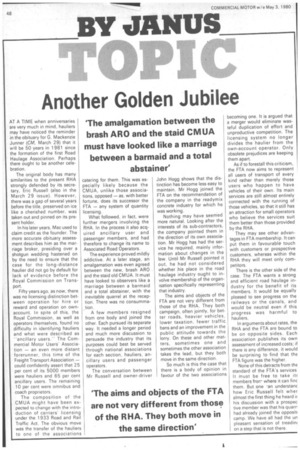Another Golden Jubilee
Page 50

If you've noticed an error in this article please click here to report it so we can fix it.
'The amalgamation between the brash ARO and the staid CMUA must have looked like a marriage between a barmaid and a total abstainer'
AT A TIME when anniversaries are very much in mind, hauliers may have noticed the reminder in the obituary for G. Mackenzie Junner (CM, March 29) that it will be 50 years in 1981 since the formation of the first Road Haulage Association. Perhaps there ought to be another celebration.
The original body has many similarities to the present RHA strongly defended by its secretary, Eric Russell (also in the March 29 issue). However, there was a gap of several years before the title, preserved on ice like a cherished number, was taken out and pinned on its present holder.
In his later years, Mac used to claim credit as the founder. The more accurate obituary assess ment describes him as the marriage broker, presiding over a shotgun wedding hastened on by the need to ensure that the case for the long-distance haulier did not go by default for lack of evidence before the Royal Commission on Transport.
Fifty years ago, as now, there was no licensing distinction bet ween operation for hire or reward and operation on ownaccount. In spite of this, the Royal Commission, as well as operators themselves, found no difficulty in identifying hauliers and what were described as "ancillary users," The Commercial Motor Users' Associa tion an even more distant forerunner, this time of the Freight Transport Association — could confidently assert that 25 per cent of its 5000 members were hauliers and 65 per cent ancillary users. The remaining 10 per cent were omnibus and coach proprietors.
The composition of the CMUA might have been ex pected to change with the intro duction of carriers' licensing under the 1933 Road and Rail Traffic Act. The obvious move was the transfer of the hauliers to one of the associations catering for them. This was especially likely because the CMUA, unlike those associatiOns, opposed — as, with better fortune, does its successor the FTA — any system of quantity licensing.
What followed, in fact, were further mergers involving the RHA. In the process it also acquired ancillary user and passenger members, and had therefore to change its name to Associated Road Operators.
The experience proved mildly addictive. At a later stage, an amalgamation was even agreed between the new, brash ARO and the staid old CMUA. It must have looked to observers like a marriage between a barmaid and a total abstainer, with the inevitable quarrel at the reception. There was no consummation.
A few members resigned from one body and joined the other. Each pursued its separate way. It needed a longer period and much more discussion to persuade the industry that its purposes could best be served through national associations for each section, hauliers, ancillary users and passenger operators.
The conversation between Mr Russell and owner-driver John Hogg shows that the distinction has become less easy to maintain. Mr Hogg joined the FTA on the recommendation of the company in the readymix concrete industry for which he was working.
Nothing may have seemed more natural. Looking after the interests of its sub-contractors, the company pointed them in the direction of its own association. Mr Hogg has had the service he required, mainly information about changes in the law. Until Mr Russell pointed it out, he had not considered whether his place in the road haulage industry ought to involve membership of the organisation specifically representing that industry.
The aims and objects of the FTA are not very different from those of the RHA. They both campaign, often jointly, for better roads, heavier vehicles, lower taxation, fewer traffic bans and an improvement in the public attitude towards the lorry. On these and other mat ters, sometimes one and sometimes the other association takes the lead, but they both move in the same direction.
So much is this the case that there is a body of opinion in favour of the two associations becoming one. It is argued that a merger would eliminate was teful duplication of effort and unproductive competition. The licensing system no longer divides the haulier from the own-account operator. Only obsolete prejudices are keeping them apart.
As if to forestall this criticism, the FTA now aims to represent all users of transport of every kind rather than merely those users who happen to have vehicles of their own. Its main services are still almost entirely connected with the running of those vehicles, so that it still has an attraction for small operators who believe the services suit them better than those provided by the RHA.
They may see other advantages in FTA membership. It can put them in favourable touch with customers or prospective customers, whereas within the RHA they will meet only com petitors.
There is the other side of the case. The FTA wants a strong and efficient road haulage industry for the benefit of its members. It would be equally pleased to see progress on the railways or the canals, and would be neutral even if this progress was harmful to hauliers.
In arguments about rates, the RHA and the FTA are bound to be on opposite sides. Each association publishes its own assessment of increased costs; if there is any difference, it would be surprising to find that the FTA figure was the higher.
None of this detracts from the standard of the ETA's services. It must be free to take it members from where it can fine them. But one an understanc how Eric Russell felt wher almost the first thing he heard ir his discussion with a prospec tive member was that his qualm had already joined the opposit, camp. We have all had the un pleasant sensation of treadim on a step that is not there.












































































































